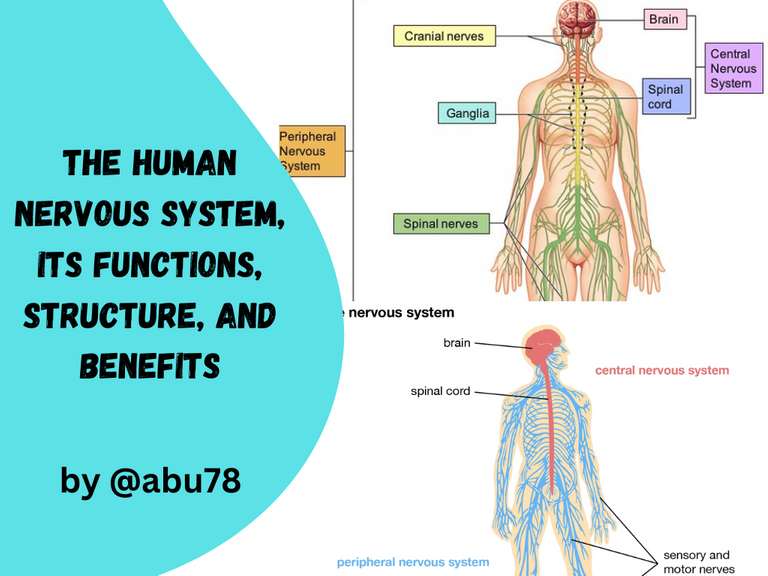The human nervous system, the structure, functions, and importance
Greetings to all and sundry on this platform once again. As a biochemistry student, today I did my research on "the human nervous system, the structure, functions, and importance" and decided to share it with you guys here. I hope that you will enjoy it and also learn from it. Stay tuned with me as I discuss this topic in my article.

The human nervous system is a complex and intricate biological system that serves as the primary means by which humans regulate and coordinate the activities of their bodies. It consists of a vast network of specialized cells known as neurons, which are responsible for receiving and transmitting information throughout the body.
The nervous system is divided into two main components: the central nervous system and the peripheral nervous system. The central nervous system consists of the brain and spinal cord, and the peripheral nervous system is composed of a collection of neurons found outside the brain and spinal cord. Together, these two systems are responsible for relaying signals between the body and the environment, allowing humans to perceive and interact with their surroundings.
The human nervous system is an essential component of human biology and provides the necessary infrastructure for all areas of daily life. It is responsible for controlling and coordinating the body’s movements, regulating essential bodily functions, and managing emotions and behavior. Its importance is such that even the slightest disruption of its operations can have serious implications for overall health.
Structure
The human nervous system is composed of two primary components: the central nervous system (CNS) and the peripheral nervous system (PNS). Together, these two systems form a complex network of specialized cells known as neurons and a variety of other supportive structures.
The CNS consists of the brain and the spinal cord and serves as the primary site of information processing and integration. It is composed of billions of neurons, which are responsible for receiving and sending signals throughout the body and connecting the body to the environment. The main neurons of the CNS are known as motor neurons, which carry signals from the brain and spinal cord to the muscles, allowing for movement.

The PNS is composed of neurons located outside of the brain and spinal cord. It is divided into two sections: the somatic nervous system and the autonomic nervous system. The somatic nervous system is responsible for transmitting signals from the brain and spinal cord to the muscles and skin, allowing humans to perceive and interact with their environment. The autonomic nervous system is responsible for controlling the body’s essential functions such as respiration, digestion, and heart rate.
Functions
The human nervous system is responsible for controlling and coordinating the body’s movements, regulating essential bodily functions, and managing emotions and behavior. It is composed of billions of neurons that act as the primary means by which the body communicates and coordinates its activities.
The CNS is responsible for receiving and interpreting sensory information from the environment, such as light, sound, and touch. It is also responsible for controlling and coordinating the body’s movements, allowing humans to interact with their surroundings. For example, when a person sees an object, their CNS receives signals from the eyes, which are then interpreted and sent to the muscles, allowing the person to reach out and grab the object.
The PNS is responsible for transmitting signals from the CNS to the muscles and organs, allowing for movement and essential bodily functions. For example, the autonomic nervous system is responsible for controlling essential functions such as respiration, digestion, and heart rate.
Importance
The human nervous system is an essential component of human biology and provides the necessary infrastructure for all areas of daily life. Its primary function is to regulate and coordinate the activities of the body, allowing humans to interact with their environment in a meaningful way. Without the nervous system, humans would be incapable of perceiving and interacting with the world around them.
The nervous system is also responsible for controlling and coordinating the body’s movements, allowing humans to perform everyday activities such as walking, running, and talking. It also regulates essential bodily functions such as respiration, digestion, and heart rate, allowing the body to remain healthy and functioning properly. Additionally, the nervous system is essential for managing emotions and behavior, allowing humans to interact with others in an appropriate manner.
The references given below are sites where you can learn more about the human nervous system.
Reference 1
Reference 2
Reference 3
Reference 4
Reference 5

Thanks for your contribution to the STEMsocial community. Feel free to join us on discord to get to know the rest of us!
Please consider delegating to the @stemsocial account (85% of the curation rewards are returned).
Thanks for including @stemsocial as a beneficiary, which gives you stronger support.